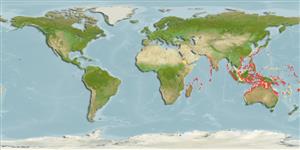Environment: milieu / climate zone / depth range / distribution range
Sinh thái học
Biển Cùng sống ở rạn san hô; Mức độ sâu 6 - 45 m (Ref. 90102). Subtropical
Indo-Pacific: in the western Pacific from the Ryukyu Islands south to the Great Barrier Reef, Lord Howe Island, and New Caledonia, east to Fiji and Samoa, and the Hawaiian Islands. Only the Chagos Archipelago in the Indian Ocean, but other localities are expected. The authors report the species for the Red Sea from a specimen from Sudan, one at Ras Bob on the southeast coast of the Sinai Peninsula, and one from the Seven Brothers Islands in the Gulf of Aden near the southern end of the Red Sea (Ref. 89154).
Known as widespread in the tropics south to Montague Island (Ref. 9002).
Bộ gần gũi / Khối lượng (Trọng lượng) / Age
Maturity: Lm ? range ? - ? cm
Max length : 4.5 cm SL con đực/không giới tính; (Ref. 48637)
Các tia vây lưng cứng (tổng cộng): 6 - 7; Các vây lưng mềm (tổng cộng): 7-9; Tia cứng vây hậu môn 1; Tia mềm vây hậu môn: 7 - 9. Dorsal-fin rays VI + I,7-I,9, usually I,8; anal-fin rays I,7-I,9, usually I,8; scales usually extending forward to above pectoral-fin base, the longitudinal scale count 33–53 (mean scale count 47); body depth at origin of anal fin 10.5–17.8% SL; body progressively compressed posteriorly; head width slightly greater than head depth; snout short, the length equal to or less than orbit diameter; gill opening extending forward to posterior margin of orbit; one or two canine teeth at side of lower jaw; caudal fin truncate with rounded corners; pelvic fins short, round, and cup-like; pelvic spines short and fleshy; nape and body transparent dorsally with seven narrow red bars that broaden as they pass onto dusky golden ventral part of body (on some individuals, the red and gold tend to merge, making the bars indistinct); a white to pale yellow line visible dorsally on vertebral column. A small species, generally less than 20 mm SL (Ref. 89154).
Known to live only on sea whips and gorgonian corals (Ref. 9002). Occurs usually with Junceela fragilis in Indonesia, that found inshore on somewhat silty reefs (Ref. 48637).
Life cycle and mating behavior
Chín muồi sinh dục | Sự tái sinh sản | Đẻ trứng | Các trứng | Sự sinh sản | Ấu trùng
Kuiter, R.H., 1993. Coastal fishes of south-eastern Australia. University of Hawaii Press. Honolulu, Hawaii. 437 p. (Ref. 9002)
IUCN Red List Status (Ref. 130435)
Threat to humans
Harmless
Human uses
Thêm thông tin
Các tài liệu tham khảoNuôi trồng thủy sảnTổng quan nuôi trồng thủy sảnCác giốngDi truyềnElectrophoresesDi sảnCác bệnhChế biếnNutrientsMass conversion
Các công cụ
Special reports
Download XML
Các nguồn internet
Estimates based on models
Preferred temperature (Ref.
123201): 24.7 - 28.9, mean 27.6 °C (based on 402 cells).
Phylogenetic diversity index (Ref.
82804): PD
50 = 0.5000 [Uniqueness, from 0.5 = low to 2.0 = high].
Bayesian length-weight: a=0.00708 (0.00333 - 0.01504), b=3.09 (2.92 - 3.26), in cm total length, based on LWR estimates for this (Sub)family-body shape (Ref.
93245).
Mức dinh dưỡng (Ref.
69278): 3.2 ±0.3 se; based on size and trophs of closest relatives
Thích nghi nhanh (Ref.
120179): Chiêù cao, thời gian nhân đôi của chủng quần tối thiểu là dưới 15 tháng (Preliminary K or Fecundity.).
Fishing Vulnerability (Ref.
59153): Low vulnerability (10 of 100).
Nutrients (Ref.
124155): Calcium = 151 [56, 377] mg/100g; Iron = 1.04 [0.44, 2.31] mg/100g; Protein = 18.4 [16.3, 20.2] %; Omega3 = 0.163 [0.064, 0.375] g/100g; Selenium = 13.1 [4.4, 35.4] μg/100g; VitaminA = 89.7 [18.7, 403.6] μg/100g; Zinc = 1.92 [1.05, 3.31] mg/100g (wet weight);
